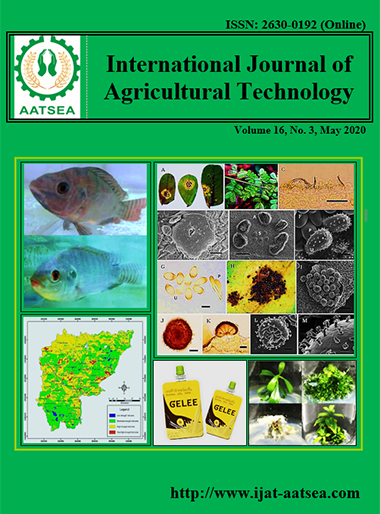Identification of genes controlling fruit shape in Thai pumpkin (Cucurbita moschata Duch.)
Main Article Content
Abstract
The genetic control of fruit shape in pumpkins was determined in the fields during 2015 and 2017. The breeding design consisted of seven crosses derived from inbred pumpkin lines. The parents originated from Thai landrace cultivars maintained by continuous selfing at Kasetsart University, Kamphaeng Saen Campus, Nakhon Pathom, Thailand. Different qualitative characters of fruit shapes of parents were chosen, including three elongated, two flattened and two globular shaped lines. The fruit shape and length/width (L/W) ratio of all parents and derived cross-progenies (F1 and F2) were evaluated. The results showed that all genotypes controlling the fruit shape hypotheses resulted from the influence of three genes. The genotype Ff, Gg, and Ee resulted in a globular fruit shape, whereas ff, gg, and ee led to an elongated shape. A flattened shape was controlled by FF, GG, and EE. In terms of gene action, the results supported ee dominance over ffG- and F-gg. The elongated shape phenotype was due to the action of ffggee, ffG-ee, and F-ggee genes. This research suggests that the analysis of fruit shape using the L/W ratio could be a useful approach for selecting other characteristics of pumpkin shapes.
Article Details

This work is licensed under a Creative Commons Attribution-NonCommercial-NoDerivatives 4.0 International License.
References
Food and agriculture organization of the United Nations (2016). Crop production stats. Retrieved from http://faostat3.fao.org/download/Q/QC/E.
Hazra, P., Mandal, A. K., Dutta, A. K. and Ram, H. H. (2007). Breeding pumpkin (Cucurbita moshata Duch. ex Poir.) for fruit yield and other characters. International Journal of Plant Breeding, 1:51-64.
Jos´E, Iban, M. A. E., Silvia, A. and Pere, A. (2005). Inheritance mode of fruit traits in melon: Heterosis for fruit shape and its correlation with genetic distance. Euphytica, 144:31-38.
Kearsey, M. J. and Pooni, H. I. S. (1996). The Genetical Analysis of Quantitative Trait. Chapman and Hall, Inc., London.
Paris, H. S. and Padley Jr, L. D. (2014). Gene List for Cucurbita species. Retrieved from http://cuke.hort.ncsu.edu/cgc/cgcgenes/gene14squash.pdf.
Paris, H. S. and Brown, R. N. (2005). The Genes of Pumpkin and Squash. HortScience, 40:1620-1630.
Périn, C., Hagen, L. S., Giovinazzo, N., Besombes, D., Dogimont, C. and Pitrat, M. (2002). Genetic control of fruit shape acts prior to anthesis in melon (Cucumis melo L.). Molecular Genetics and Genomics, 266:933-941.
Shapiro, S. S. and Wilk, M. B. (1965). An analysis of variance test for normality (complete samples). Biometrika, 52:591-611.
Tanaka, T., Wimol, S. and Mizutani, T. (1995). Inheritance of Fruit Shape and Seed Size of Watermelon. Journal of the Japanese Society for Horticultural Science, 64:543-548.
Wang, Y. H., Behera, T. K. and Kole, C. (2012). Genetics, Genomics and Breeding of Cucurbits. Taylor&Francis Group. Boca Raton, FL.
Zhang, S., Hu, J. and Xu, S. (2008). Developmental genetic analysis of fruit shape traits under different environmental conditions in sponge gourd (Luffa cylindrical (L) Roem. Violales, Cucurbitaceae). Genetics and Molecular Biology, 31:704-710.
Zhang, S., Hu, J., Zhang, C., Guan, Y. and Zhang, Y. (2007). Genetic analysis of fruit shape traits at different maturation stages in sponge gourd. Journal of Zhejiang University-SCIENCE B, 8:338-344.


